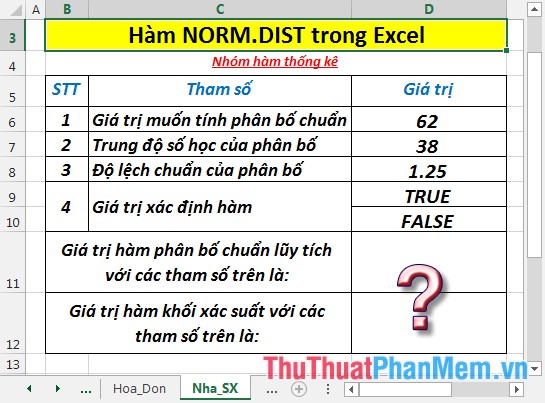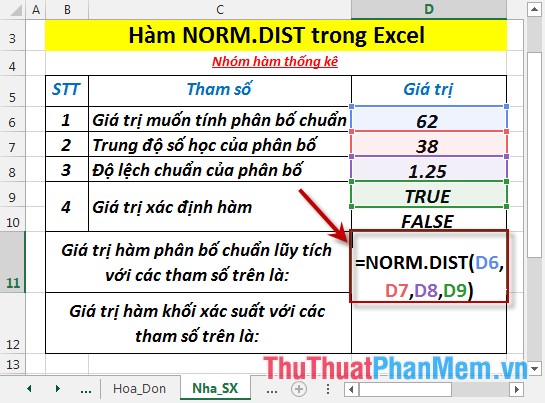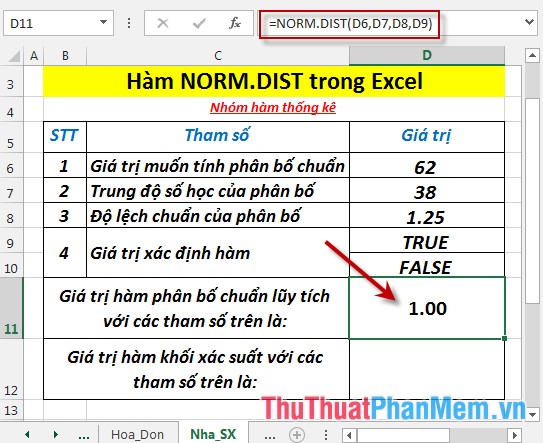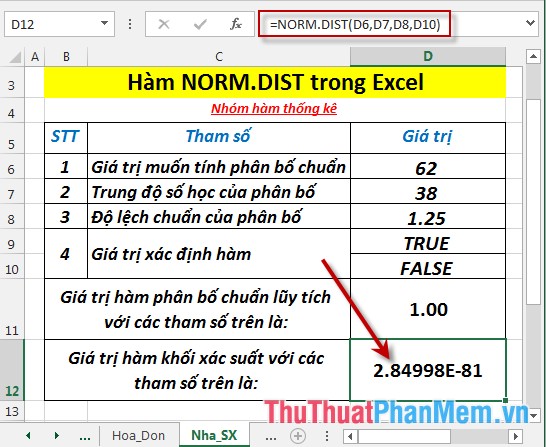NORM.DIST function - The function returns the normal distribution with the standard deviation and the mean value specified in Excel
The following article introduces you to the NORM.DIST function - one of the functions in the statistical function group is very popular in Excel.

Description: The function returns the normal distribution with a specified standard deviation and mean. Functions widely used in hypothesis testing statistics. Support functions from Excel 2010 onwards.
Syntax: NORM.DIST (x, mean, standard_dev, cumulative)
Inside:
- x: The value you want to calculate the normal distribution, is a required parameter .
- mean: Arithmetic mean of distribution, is a required parameter.
- standard_dev: The standard deviation of the distribution, is a required parameter.
- cumulative: A logical value that determines the form of the function, which is a required parameter, including:
+ cumulative = True -> returns the cumulative distribution function.
+ cumulative = False -> returns the probability density function.
Attention:
- If mean, standard_dev is not an integer -> they are truncated to integers.
- If mean, standard_dev is not a number -> the function returns the #VALUE! Error value
- If standard_dev ≤ 0 -> the function returns the #NUM! Error value
- If mean = 0 , standard_dev = 1 and cumulative = TRUE -> the function returns the normal distribution.
- The equation for the standard density function (cumulative = True) is:
[f (x; mu, sigma) = frac {1} {{sqrt {2pi} sigma}} {e ^ {- left ({frac {{{{left ({N - mu} right)} ^ 2}} } {{2 {sigma ^ 2}}}} right)}}]
- If cumulative = True -> the formula is integral from negative infinity to x.
For example:
Find the cumulative and probability normal distribution with the values in the data table below:

- Calculate cumulative standard distribution (corresponding to True value ) . In a cell to calculate, enter the formula : = NORM.DIST (D6, D7, D8, D9)

- Press Enter -> cumulative standard distribution is:

- Calculate the value of the probability block function (corresponding to the value of False) . In a cell to calculate, enter the formula : = NORM.DIST (D6, D7, D8, D10)

- Press Enter -> the probability function value is:

- There is a rather large difference in value between the cumulative standard distribution function and the probability distribution.
Above are instructions and some specific examples when using the NORM.DIST function in Excel.
Good luck!
You should read it
- NORM.S.INV function - The function returns the inverse of the normalized distribution with an average value of 0 and a standard deviation of 1 in Excel
- LOGNORM.DIST - Function returns the logarithmic distribution of x in Excel
- POISSON.DIST function - The function returns the Poisson distribution in Excel
- NORMDIST function - The function returns the normal distribution with the standard deviation and the average value specified in Excel
- GAMMA.DIST function - The function returns the gamma distribution in Excel
- BETA.DIST function - The function returns the Beta distribution in Excel
- HYPGEOM.DIST - The function returns the hyperbolic distribution in Excel
- F.DIST - The function returns the probability distribution F in Excel
May be interested
- LOGNORM.DIST - Function returns the logarithmic distribution of x in Excel
 lognorm.dist: the function returns the logarithmic distribution of x. where ln (x) is usually distributed with parameter mean and standard deviation. support functions from excel 2010 onwards. syntax: lognorm.dist (x, mean, standard_dev, cumulative)
lognorm.dist: the function returns the logarithmic distribution of x. where ln (x) is usually distributed with parameter mean and standard deviation. support functions from excel 2010 onwards. syntax: lognorm.dist (x, mean, standard_dev, cumulative) - WEIBULL function - The function returns the Weibull distribution in Excel
 the function performs the calculation and returns the weibull distribution. based on this distribution to analyze reliability in theory such as calculating the average life of the device or used in the field of meteorology, hydrology and weather forecast.
the function performs the calculation and returns the weibull distribution. based on this distribution to analyze reliability in theory such as calculating the average life of the device or used in the field of meteorology, hydrology and weather forecast. - NORMSDIST function - The function returns the normal cumulative distribution in Excel
 the following article details how to use the normsdist function - the function returns the cumulative normal distribution in excel.
the following article details how to use the normsdist function - the function returns the cumulative normal distribution in excel. - How to use NORMDIST function in Excel
 normdist is a function that returns a distribution with a standard deviation and a confirmed average. the normdist function applies in statistics, including hypothesis testing.
normdist is a function that returns a distribution with a standard deviation and a confirmed average. the normdist function applies in statistics, including hypothesis testing. - BINOM.INV function - The function returns the smallest value with cumulative binomial distribution greater or equal to the standard value in Excel
 binom.inv function: the function returns the smallest value with cumulative binomial distribution greater or equal to the standard value. support functions from the excel 2010 version. syntax: binom.inv (trials, probability_s, alpha)
binom.inv function: the function returns the smallest value with cumulative binomial distribution greater or equal to the standard value. support functions from the excel 2010 version. syntax: binom.inv (trials, probability_s, alpha) - GAMMA.INV function - The function returns the inverse of the gamma distribution in Excel
 gamma.inv: the function returns the inverse of the gamma distribution, using this function to study their distribution variables that may be symmetrical. support functions from excel 2010 onwards. syntax: gamma.inv (probability, alpha, beta)
gamma.inv: the function returns the inverse of the gamma distribution, using this function to study their distribution variables that may be symmetrical. support functions from excel 2010 onwards. syntax: gamma.inv (probability, alpha, beta) - GAMMA.DIST function - The function returns the gamma distribution in Excel
 gamma.dist: the function returns the gamma distribution, using this function to study skewed distribution variables. support functions from excel 2010 onwards. syntax: gamma.dist (x, alpha, beta, cumulative)
gamma.dist: the function returns the gamma distribution, using this function to study skewed distribution variables. support functions from excel 2010 onwards. syntax: gamma.dist (x, alpha, beta, cumulative) - CHIDIST function - Function returns the right end probability of the distribution when squared in Excel
 the following article introduces the chidist function - the function returns the right end probability of a distribution when the distribution helps you have a basis to determine the correctness of the expected with the original hypothesis.
the following article introduces the chidist function - the function returns the right end probability of a distribution when the distribution helps you have a basis to determine the correctness of the expected with the original hypothesis. - POISSON.DIST function - The function returns the Poisson distribution in Excel
 poisson.dist function: the function returns the poisson distribution, the application function to predict the number of events in a specific time. support functions from excel 2013 onwards. syntax: poisson.dist (x, mean, cumulative)
poisson.dist function: the function returns the poisson distribution, the application function to predict the number of events in a specific time. support functions from excel 2013 onwards. syntax: poisson.dist (x, mean, cumulative) - BETA.DIST function - The function returns the Beta distribution in Excel
 beta.dist function: the function returns the beta distribution to study the variability of a number of things through a sample. support functions from excel 2010 onwards. syntax: beta.dist (x, alpha, beta, cumulative, [a], [b])
beta.dist function: the function returns the beta distribution to study the variability of a number of things through a sample. support functions from excel 2010 onwards. syntax: beta.dist (x, alpha, beta, cumulative, [a], [b])










 NORM.INV function - The function returns the inverse of the standard cumulative distribution in Excel
NORM.INV function - The function returns the inverse of the standard cumulative distribution in Excel NORM.S.DIST function - The function returns the normalized distribution with a mean of 0 and a standard deviation of 1 in Excel
NORM.S.DIST function - The function returns the normalized distribution with a mean of 0 and a standard deviation of 1 in Excel PEARSON function - The function returns the Pearson product moment correlation coefficient in Excel
PEARSON function - The function returns the Pearson product moment correlation coefficient in Excel PERCENTILE.EXC function - The function returns the kth percentile of values in the range, with k in the range from 0 to 1 in Excel
PERCENTILE.EXC function - The function returns the kth percentile of values in the range, with k in the range from 0 to 1 in Excel PERCENTILE.INC function - Function returns the kth percentile of values in the range with k in the range from 0 to 1 in Excel
PERCENTILE.INC function - Function returns the kth percentile of values in the range with k in the range from 0 to 1 in Excel PERMUT function - The function returns the number of permutations of a given number of objects in Excel
PERMUT function - The function returns the number of permutations of a given number of objects in Excel